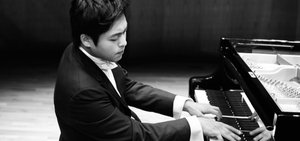Korean Sounds - East Meets West: Space

Korean Sounds - East Meets West: Space
Korean Sounds - East Meet West: Space
Wednesday 2 August, 7.30pm
Kings Place, Hall One
In the third concert, we listen to ‘Yeongsanhoesang’ and more of Franz Liszt. Originally ‘Yeongsanhoesang’ was Buddhist vocal music and transmitted with court dance. However, Buddhist influences of the music disappeared during the Confucian Joseon dynasty, and it became the most representative of Confucian scholars' music. Cellist Sung-Won Yang and pianist Enrico Pace then take us to the European intellectual’s world of the 19th century. Liszt was not only a composer and virtuoso pianist - he was also a conductor, teacher, arranger, organist, philanthropist and author. In his late works, he turned away from the virtuosity and his music became more contemplative, almost philosophical.
Programme:
Hyeonak Yeongsanhoesang
– Sangnyeongsan, Jungnyeongsan, Seryeongsan, Garakdeori, Sanghyeondodeuri, Hahyeondodeuri,
Yeombuldeuri, Taryeong, Gunak
Liszt
2 Elegies, S130 & S131
Romance oubliée, S132
La lugubre gondola, S134
Die Zelle in Nonnenwerth, S382
Pensées poétiques / Consolations Nos 1-6, S172
Ave Maria, S173 No.2
Cantique d’Amour, S173
Chopin Polonaise brillante in C for cello and piano, Op. 3
Artists:
Sungwon Yang cello
Enrico Pace piano
Members from the National Gugak Center:
Jong Gil Lee gayageum – Korean zither with 12 strings
Bang Sil Lee geomungo – black crane zither
Hyun Woo Hong sepiri – small double-reed oboe
Young Hun Kim daegeum– bamboo transverse flute
Hyung Sub Kim yanggeum – hammered dulcimer
Soo Young Ko haegeum –fiddle-like string instrument
Jong Bum Lee danso – vertical bamboo flute
Suk Bok Hong janggu – double-headed drum
The Court Music Orchestra of National Gugak Center:
The Court Music Orchestra has been a part of the National Gugak Center throughout its entire history, performing and handing down royal court music in the spirit of Korean traditional culture. In general, the court music of Korea that is performed today mainly consists of pieces which were played in the royal court or in events organized by the royal household of the Joseon Dynasty (1392–1910). Some genres of court music were created during the Joseon Dynasty, whereas origins of other genres pre-date these. Court music served as a medium for people to live in a harmonious way as well as an important mode of communication in a variety of court rituals and banquets. In modern times, it is still enjoyed by Korean people who appreciate its beauty of movement and its stillness. Among this great tradition, Jongmyo Jeryeak (Royal Ancestral Shrine Music of Joseon Dynasty) was designated in 2001 as a part of the world cultural heritage list by UNESCO, substantiating its value and importance.
Bio - Sung-Won Yang & Enrico Pace
Sung-Won Yang is a South Korean cellist who performs worldwide as a soloist and as a chamber musician. He studied with Philippe Muller and Janos Starker. He has performed in Paris, Amsterdam, London, Rome, Frankfurt, Madrid, Prague, Helsinki, New York, Washington D.C, Boston, Seattle, Tel Aviv, Shanghai, Tokyo, Osaka, Beijing and Sydney among other cities.
Enrico Pace was born in Rimini, Italy. He studied piano with Franco Scala both at the Rossini Conservatory, Pesaro, where he graduated in Conducting and Composition, and later at the Accademia Pianistica Incontri col Maestro, Imola. Jacques De Tiège was a valued mentor. Winning the Utrecht International Franz Liszt Piano Competition in 1989 marked the beginning of his international career.




